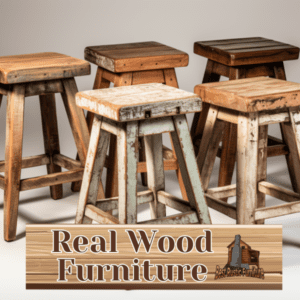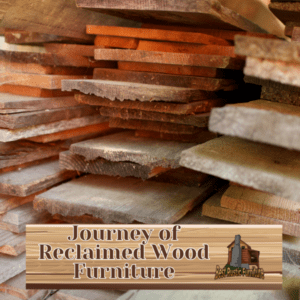
Reclaimed wood is a material that has gained significant popularity in recent years, celebrated for its uniqueness, character, and environmental benefits. This article explores the beauty and stories behind reclaimed wood, shedding light on its history, environmental significance, and its use in interior design and architecture.
By delving into the origins and historical significance of reclaimed wood, we uncover the stories embedded within each grain. we examine the environmental benefits of utilizing reclaimed wood, such as reducing deforestation and promoting sustainable design practices.
Furthermore, we explore the challenges and considerations of using reclaimed wood and discuss the future of this material, including innovation and technology within the reclaimed wood industry. Join us on this journey to discover the beauty that lies within the grain of reclaimed wood.
Key takeaways:
- Reclaimed wood tells a story: Each piece of reclaimed wood has a unique history, adding character and depth to any design or construction project.
- Environmental benefits of reclaimed wood: By using reclaimed wood, we can reduce deforestation, carbon footprint, and promote sustainable design practices.
- Reclaimed wood in modern spaces: Incorporating reclaimed wood into interior design and architecture brings a rustic charm and a connection to nature, creating warm and inviting spaces.
The Beauty of Reclaimed Wood
The beauty of reclaimed wood is truly unmatched, as it possesses a unique and irreplaceable charm. Each piece of this wood tells a captivating story through its distinct grain and character, infusing depth and allure into any given space. The rustic and weathered appearance, brought about by the history and imperfections of reclaimed wood, further enhances its appeal. Whether it is the utilization of a reclaimed barn beam as a mantel or incorporating reclaimed floorboards into furniture, the beauty of this wood effortlessly adds warmth and character to any design. Its incorporation into your space not only brings stunning beauty but also promotes sustainability by breathing new life into old materials.
What is Reclaimed Wood?
What is Reclaimed Wood?
Reclaimed wood, also known as salvaged wood, is a sustainable material that has been repurposed from its original use for other projects. It provides a second life to materials that would otherwise be wasted. The sources of reclaimed wood are diverse and can include old barns, factories, or even sunken logs. The appeal of this type of wood lies in its unique character, durability, and eco-friendliness. A furniture maker once embarked on an inspiring journey to transform reclaimed wood obtained from an abandoned factory into exquisite handcrafted tables. This not only preserved the history of the wood but also showcased its natural beauty.
What Makes Wood Reclaimed?
Reclaimed wood refers to wood that has been salvaged from old structures, such as barns, factories, or warehouses, and repurposed for new projects. “What makes wood reclaimed?” It is considered reclaimed when it retains its original characteristics, such as unique grain patterns and nail holes, which add character and charm to the wood. What makes wood reclaimed is not just its age, but also the story it carries and the history it represents. By using reclaimed wood, we can give new life to materials that would otherwise go to waste, reducing the demand for fresh timber and promoting sustainability in design and construction. Consider using reclaimed wood for your next project to add a touch of history and contribute to a more eco-friendly future.
The History and Stories Behind Reclaimed Wood
Unlock the captivating world of reclaimed wood as we dive into its rich history and stories. Discover the origins of this unique material and uncover its extraordinary historical significance. Ready to be amazed by the tales hidden within the grains of reclaimed wood? Let’s embark on a journey that unravels the captivating past of this fascinating resource.
The Origins of Reclaimed Wood
The origins of reclaimed wood can be traced back to various sources, each with its own unique history and story. One common origin of reclaimed wood is old buildings, barns, and structures that have been dismantled or renovated. This wood carries with it the character and charm of its previous life, showcasing the wear and patina that can only come with age. Another source of reclaimed wood is salvaged timber from forests, often due to natural disasters like storms or wildfires. By repurposing this wood, we not only give it a new lease on life but also honor its rich history and promote sustainable design practices.
Historical Significance of Reclaimed Wood
Reclaimed wood holds tremendous historical significance as it vividly portrays the tales of the past. It carries the remarkable imprints of time, gracefully revealing the enduring marks left by skilled artisans and craftsmen from various eras. Each magnificent piece of reclaimed wood showcases a captivating and unparalleled history, ultimately adding charisma and allure to any given space. It may originate from ancient barns, factories, or even prestigious historic landmarks, effortlessly connecting us to our rich heritage. By opting for reclaimed wood, we actively preserve and cherish the cherished past, while simultaneously valuing the craftsmanship involved, all in pursuit of a sustainable and responsible future. In truly embracing this commendable practice, we wholeheartedly recognize and admire the profound historical significance embedded within reclaimed wood and the extraordinary stories it perpetually holds dear.
Fact: Did you know that certain pieces of reclaimed wood can date back over a century? The age and extraordinary history of such wood greatly contribute to its unparalleled beauty and irresistible appeal.
The Environmental Benefits of Reclaimed Wood
When it comes to the beauty of reclaimed wood, there’s more than meets the eye. In this section, we dive into the environmental benefits that come with embracing this sustainable material. From reducing deforestation and our carbon footprint to promoting sustainable and responsible design, the impact of reclaimed wood reaches far beyond aesthetics. Get ready to uncover the stories behind the grain and discover how this eco-friendly choice can make a real difference.
Reducing Deforestation and Carbon Footprint
Reducing deforestation and carbon footprint is one of the key benefits of utilizing reclaimed wood. By repurposing old wood from buildings, furniture, or other sources, we can effectively prevent the need to cut down new trees and contribute to the preservation of forests. In addition, the practice of reclaiming wood significantly reduces the carbon emissions associated with logging and the manufacturing of new wood products. Opting for reclaimed wood in construction, furniture, or decorative purposes not only minimizes environmental impact but also promotes sustainability. Embracing the use of reclaimed wood allows us to create exquisite and distinctive pieces while having a positive impact on the planet. I encourage you to consider incorporating reclaimed wood into your next design project or supporting businesses that prioritize the noble cause of reducing deforestation and carbon footprint.
Promoting Sustainable and Responsible Design
When it comes to using reclaimed wood in design, there are several ways it promotes sustainable and responsible design:
- Reducing deforestation: By using reclaimed wood, we can minimize the demand for new timber, leading to less destruction of forests.
- Lowering carbon footprint: Reclaimed wood has a significantly lower carbon footprint compared to new wood as it doesn’t require harvesting, transportation, or processing.
- Preserving history and culture: Reclaimed wood carries the stories and character of its previous life, adding a unique charm and cultural significance to any design.
- Creating a circular economy: By giving old wood a new purpose, we contribute to a more sustainable and circular economy.
Embracing reclaimed wood in design not only enhances the aesthetic appeal but also showcases a commitment to promoting sustainable and responsible design practices for a greener future.
Reclaimed Wood in Interior Design and Architecture
Reclaimed wood has become a cornerstone of interior design and architecture, adding a touch of history and character to modern spaces. Let’s explore the popular uses of reclaimed wood and how it can be seamlessly incorporated into contemporary designs. Get ready to discover the beauty and allure of using this timeless material, as we delve into the stories behind the grain.
Popular Uses of Reclaimed Wood
Reclaimed wood has become increasingly popular in interior design and architecture due to its unique character and sustainable nature. When it comes to incorporating popular uses of reclaimed wood, here are some ideas to inspire you:
1. Flooring: By using reclaimed wood flooring, you can add a warm and rustic charm to any space in your home.
2. Furniture: From coffee tables to bed frames, incorporating reclaimed wood furniture can bring a timeless and eco-friendly touch to your living environment.
3. Wall cladding: To create stunning accent walls that add texture and depth to a room, consider using reclaimed wood.
4. Shelving and bookcases: Reclaimed wood shelves and bookcases offer both functionality and a touch of natural beauty to your home.
5. Kitchen and bathroom fixtures: Get creative by using reclaimed wood to design unique countertops, vanities, and cabinets that will add a special touch to these spaces.
By embracing reclaimed wood in your design, you not only create a visually appealing space but also contribute to sustainability efforts. So, consider these popular uses of reclaimed wood for your next project and invite the beauty of this eco-friendly material into your home.
Incorporating Reclaimed Wood into Modern Spaces
Incorporating reclaimed wood into modern spaces can add a unique and rustic charm to any design. Here are some ideas on how to incorporate reclaimed wood into modern spaces:
- Create an accent wall using reclaimed wood planks for a focal point in a room.
- Use reclaimed wood as flooring to add warmth and character to the space.
- Build reclaimed wood furniture pieces, such as a coffee table or bookshelf, to add a touch of history to the room.
- Add architectural details with reclaimed wood, like using it for ceiling beams or wall paneling.
- Create custom reclaimed wood shelves to display artwork, plants, or decorative items.
Fact: Incorporating reclaimed wood into modern spaces not only adds aesthetic appeal, but it also helps to reduce waste and promote sustainability in construction.
The Challenges and Considerations of Using Reclaimed Wood
Using reclaimed wood can be a beautiful and sustainable choice for various projects, but it also comes with its fair share of challenges and considerations. In this section, we will explore these challenges and delve into the important considerations when using reclaimed wood. From maintaining quality and durability to addressing pests and other concerns, we will uncover the key factors that need to be taken into account. Get ready to discover the ins and outs of working with reclaimed wood in all its unique glory.
Maintaining Quality and Durability
Maintaining quality and durability is paramount when using reclaimed wood in construction and design projects. Here are some key factors to consider to ensure both:
- Thoroughly inspect each piece of reclaimed wood for any indications of rot, infestation, or structural weakness.
- Apply suitable treatments, such as wood preservatives and sealants, to safeguard against moisture, pests, and UV damage.
- Implement a regular maintenance schedule to uphold the wood’s beauty and longevity. This may involve cleaning, repainting, or resealing as necessary.
- Guarantee proper installation methods by employing experienced professionals who understand the unique properties and challenges of reclaimed wood.
- Maintain stable humidity levels and temperature to prevent warping, shrinking, or expanding of the wood.
- Consider the reclaimed wood’s origin, including its past use and exposure, to gain insights into its potential durability and maintenance requirements.
Addressing Pests and Other Concerns
To address pests and other concerns when using reclaimed wood, follow these steps:
- Thoroughly examine the reclaimed wood for signs of pest infestation, such as holes, burrows, or sawdust, in order to effectively address pests and other concerns.
- If pests are detected, treat the wood with appropriate insecticides or fumigation methods to eliminate any existing pests, thereby addressing pests and other concerns.
- To prevent future infestations, apply protective coatings or treatments to the wood, deterring pests from returning or infesting the wood in the future and addressing pests and other concerns.
- Store reclaimed wood in a dry, well-ventilated area away from moisture or dampness to ensure proper storage and prevent attracting pests, thereby addressing pests and other concerns.
- Regularly inspect and maintain the reclaimed wood to promptly detect any signs of reinfestation or other concerns, and take necessary actions to address pests and other concerns accordingly.
The Future of Reclaimed Wood
In the ever-evolving world of reclaimed wood, the future holds exciting possibilities. Join us as we delve into the next chapter of this captivating industry. From innovative technology shaping the way reclaimed wood is used, to a growing emphasis on sustainable design and construction practices, we’ll uncover the fascinating trends that are shaping the future of reclaimed wood. Get ready to explore a world where craftsmanship meets environmental consciousness in the realm of reclaimed wood.
Innovation and Technology in Reclaimed Wood Industry
Advancements in innovation and technology have completely transformed the reclaimed wood industry, making it significantly easier to repurpose and reuse wood. Companies are now utilizing cutting-edge techniques to salvage wood from old buildings and skillfully craft it into exquisite furniture and architectural elements. The utilization of state-of-the-art technology, such as laser scanning and computer-controlled machinery, enables precise measurements and cuts, leading to minimal waste and optimal efficiency. Furthermore, digital platforms and marketplaces have emerged, seamlessly connecting buyers and sellers of reclaimed wood worldwide. This seamless integration of innovation and technology has not only expanded the reclaimed wood market but has also fostered sustainable practices, preserving the distinctive beauty and historical significance of each individual piece.
Embracing a Sustainable Mindset in Design and Construction
Embracing a sustainable mindset in design and construction is crucial for the future of reclaimed wood. Designers and builders can contribute to a more environmentally friendly industry by prioritizing the use of reclaimed wood in their projects. This sustainable approach involves sourcing wood from old structures and giving them new life, reducing the need for harvesting new timber. By incorporating reclaimed wood, we can minimize deforestation and carbon footprint, while promoting responsible design practices. Embracing this sustainable mindset not only benefits the environment but also adds unique character and history to the spaces we create.
Incorporating a sustainable mindset in design and construction is of utmost importance for the future of reclaimed wood. It is essential for designers and builders to prioritize the use of reclaimed wood in their projects to contribute to a more environmentally friendly industry. This approach to sustainability entails sourcing wood from old structures and revitalizing them, thereby reducing the necessity of harvesting new timber. By incorporating reclaimed wood, we have the power to minimize deforestation and our carbon footprint, while simultaneously endorsing responsible design practices. The embracement of this sustainable mindset not only yields environmental benefits but also imparts distinctive character and historical essence to the spaces we create.
The Beauty of Reclaimed Wood: Stories Behind the Grain
- ✅ Reclaimed wood adds a sense of history to any space.
- ✅ Manomin offers unique antique wooden treasures made from reclaimed wood.
- ✅ Reclaimed wood flooring showcases original saw marks, wormholes, and mortise pockets.
- ✅ Reclaimed wood paneling features natural patina, nail marks, and wormholes.
- ✅ Using reclaimed wood in your home sparks conversations about its history.
Frequently Asked Questions
1. What are some popular applications for reclaimed wood in home design?
Reclaimed wood is commonly used for flooring and paneling to showcase its unique characteristics and style.
2. What makes reclaimed wood flooring so captivating?
Reclaimed wood flooring, like Antique Ash or Wormy Chestnut, features original saw marks, wormholes, and natural aging, resulting in a charming Old World appeal.
3. How can reclaimed wood paneling transform a space?
Reclaimed wood paneling, such as Weathered Antique or Faded Red Barn Wood, adds an authentic and rustic aesthetic with original saw markings, nail marks, and natural patina.
4. Where does Manomin source their reclaimed wood?
Manomin sources wood from various locations across the country, ensuring a diverse range of histories and characteristics in their reclaimed wood products.
5. What are the benefits of using reclaimed wood in home design?
Using reclaimed wood infuses a space with a sense of history and rustic appeal that cannot be replicated by modern trends or materials.
6. Is reclaimed wood a sustainable and ethical choice for home design?
Yes, reclaimed wood repurposes materials that would otherwise go to waste, making it an environmentally-friendly option. Manomin takes pride in ethically producing their reclaimed wood products.






